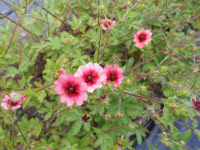Description
Summer to autumn, ruby to pumpkin-colored blossoms shaped like a single petal rose, top pleated silvery foliage.
Open pink cups in June-July
Summer to autumn, ruby to pumpkin-colored blossoms shaped like a single petal rose, top pleated silvery foliage.
Fast-growing, pyramidal-shaped deciduous conifer. The orange to brown trunk base tapers and thickens with up to a dozen large buttress-like root flares extending several feet up the trunk. Feathery, fern-like, soft foliage emerges light green in spring, and turns red-bronze in fall before dropping. Its branches are well-attached and make excellent climbing.
Size: 70-90’ x 15-25’
Care: sun in moist to moist well-drained, slightly acid soil
Native: Szechuan China
Awards: Royal Botanic Garden Award of Garden Merit, Yew Dell Botanical Gardens’ Theodore Klein Plant Awards & Pennsylvania Horticultural Society Gold
From fossil records, dawn redwood is known to have existed as many as 50,000,000 years ago. However, it was not until 1941 that dawn redwood was first discovered growing in the wild near the town of Modaoqi China by Chinese forester, T. Kan. Seeds collected from the original site were made available to the Missouri Botanical Garden in 1947. Seedlings grown therefrom were planted in front of the Lehmann Building at MBG in 1952 where they have now developed into large mature trees (70’+ tall). Dawn redwood is a deciduous, coniferous tree that grows in a conical shape to 100’ tall. It is related to and closely resembles bald cypress (Taxodium) and redwood (Sequoia).
Small purple flowers atop tall leafless stems from July to October. Great see-through blooms for growing in back, middle or front of the garden.
Size: 3-4’ x 8”
Care: full sun in moist, well-drained, fertile soil - self-seeder
Native: South America
Awards: Royal Horticultural Society Award of Merit & Missouri Botanic Garden Plant of Merit.
Introduced to garden cultivation from its native Buenos Aires in 1726 by the Sherard brothers.
OUT OF STOCK
Outfacing, white, waxy cup-shaped flowers resembling single roses in late winter, evergreen leaves.
Size: 12-20” x 12”
Care: part shade in moist well-drained soil
Native: rocky places in Europe
Awards: Received Royal Horticultural Society Award of Merit.
The name Helleborus is Greek from hellein meaning “to kill” and bora meaning “food” referring to the plant’s poisonous qualities if placed in food. This species is ancient – known as long ago as 300 BC in Greece where it “purged and cured the mad or melancholicke daughters of Praetus with the roots thereof.” (Parkinson, 1629) Grown in the Eichstätt Garden, the garden of Johann Konrad von Gemmingen, prince bishop of Eichstätt in Bavaria, c. 1600. In Middle Ages petals thrown on floor to drive out evil and ward off power of witches. English herbalist John Gerard (1545-1612) strangely recommended it for curing poisoned animals. Sorcerers made themselves invisible by tossing the powdered plant in the air.
OUT OF STOCK
Rosettes of succulent leaves
Size: 4” x 4”
Care: sun in well-drained to moist well-drained soil
Native: Alps & Pyrenees Mountains
Grown in gardens for thousands of years. Sempervivum means “live forever.” Romans planted Hens and chicks on their roofs to ward off lightning. As a succulent it holds water and is probably more difficult to catch fire. “This practice was preserved for historians when Charlemagne (720-814), first Holy Roman Emperor and unifier of a large part of northern Europe, ordered that all villagers within his crown lands plant houseleeks on their roofs, presumably as a safety measure. He decreed: Et ille hortulanus habeat super domum suam Iovis barbam. (And the gardener shall have house-leeks growing on his house. Capitulare de villis, about 795, LXX.)”

